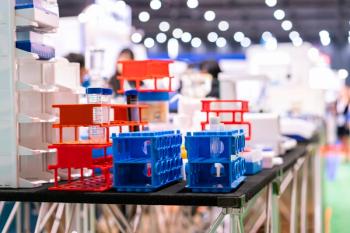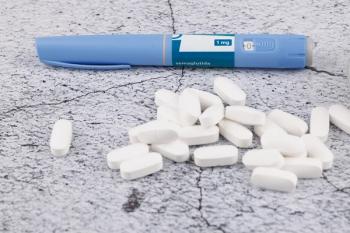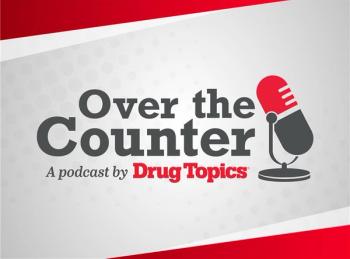
UP, UP, and AWAY
Pharmacist shortages send salaries soaring around the country, new national survey finds
COVER STORY
UP, UP, and AWAY
Pharmacist shortages send salaries soaring around the country, new national survey finds
Come on, fess up, pharmacists. Did you ever think you'd see the day when the average base salaries of employee pharmacists that Drug Topics and Hospital Pharmacist Report track every two years would jump by more than $10,000 to break the $70,000 barrier? Did you ever think you'd see the day when nearly 40% of our respondents would say the boss gave them a bigger raise than they expected just to keep them on the job? Did you ever think you'd see the day when the new kids on the bench would earn an average hourly pay of $32.11? Can you say pharmacist shortage?
Employee pharmacists have begun to resemble baseball free agentswell, not quite. And employers desperate to keep pharmacies churning out nearly three billion prescriptions annually have opened the company coffers for anyone with a pharmacy degree. For example, the average base salary of a chain drugstore pharmacist went from $62,831 in our 1999 survey to $74,154 this time around, a jump of $11,323 in just two years. Feeling the hot breath of corporate pharmacy recruiters eager to steal their staff R.Ph.s, hospitals have been forced to fork over even more money to stay in the game; the average hospital base wage of $59,491 in 1999 rose to $72,452 this time around, up an astounding $12,961.
Pharmacists who are paid by the hour averaged $34.91 per 60 minutes, up from $32.23 the previous year. The hourly rate ranged from a high of $36.55 among mass-merchandisers and $36.22 among chains to $31.79 among independents. In keeping with the westward trend, chain pharmacists paid by the hour on the Left Coast there earned the most, $39.18. Southern independent employee R.Ph.s lagged behind, earning an average of $30.86 per hour.
New pharmacists continued to ride the crest of the shortage, as starting base salaries across all practice settings shot up $12,500 during the past two years. Since our survey in 1997, starting wages have gone from an average of $51,010 to the current $67,824. That's only $3,854 less than the average base wage of all pharmacists across all settings.
New hires at independent pharmacies scored the biggest jump in starting base pay. They averaged $62,040, a $12,407 hike from our 1999 survey. Beginning base wages at supermarkets were up $12,343, mass-merchandisers paid $12,218 more, and chains coughed up an additional $11,725 to bring on board a rookie pharmacist. Hospitals got away with paying a mere $10,840 more this time around. The current hikes come on top of jumps of $4,000 to $6,000 between our 1997 and 1999 surveys, so that in the past five years starting salaries have skyrocketed $14,000 to $18,000. Not exactly chump change.
While the rising manpower shortage floats all boats, some pharmacists are cruising along in first class while others are berthed on the tourist tier. For example, Midwestern independent employee pharmacists had to make do with a base salary of $62,595, while chain pharmacists in the West were racking up an average base pay of $84,803.
Excluding HMOs (due to a small respondent base), the highest paid breadwinners were pharmacists who work for mass-merchandisers, such as Kmart and Wal-Mart. The average base pay for that setting was $75,631. Chains were next best, with an average of $74,154. The average base pay among hospital R.Ph.s was $72,452. Bringing the overall base pay down somewhat were independent employee R.Ph.s, who averaged $65,215.
On the clock
The typical pharmacist in the Drug Topics-Hospital Pharmacist Report survey logged 42 hours during the average five-day workweek. But 72% of our respondents racked up overtime, compared with 67% in our 1999 survey. While 60% said they worked about the same amount of overtime as the previous year, 24% said they stayed on the clock longer. Eighty-three percent of supermarket pharmacists worked overtime, as did 80% of chain and 78% of mass-merchandiser pharmacists. About 67% of hospital R.Ph.s worked overtime, while only 54% of independent employee pharmacists pulled extra duty. On average, pharmacists who worked overtime put in extra hours during 19 weeks last year. Pharmacists who worked overtime averaged an extra 11 hours each week, up from seven hours in our 1999 survey.
Western chain R.Ph.s were our overtime champs. The 84% who stayed late toiled an average of 18 hours each of the 28 weeks they worked overtime. Fifty-eight percent of independent R.Ph.s in the West worked overtime for an average 27 weeks but for only five hours per week.
The most common compensation for overtime was the regular hourly wage (34%) across all practice settings, but 27% were paid time and a half. Pharmacists in independent pharmacies (30%) and hospitals (29%) were the least likely to be paid for overtime hours, compared with the 18% overall who gave the boss free labor. But 15% of independents and 16% of hospitals gave employee R.Ph.s comp time in lieu of overtime pay, compared with the overall average of 8%.
Among R.Ph.s who worked extra and were paid for it, the average compensation ranged from $4,433 for independents to $5,552 for mass- merchandiser and $5,550 for chain R.Ph.s.
During a typical five-day work week, women worked 40 hours, two fewer than men. Compared with men, women worked overtime roughly three to four fewer weeks during the year but about the same number of extra hours per week.
Under a keep-the-worker-bee-happy philosophy, many employers hand out bonuses. In fact, 88% of our respondents had been blessed by the boss by the time our survey was mailed out last December. Among pharmacists who had cashed a bonus check, the average amount was $2,373 across all settings. The amounts ranged from $2,172 among independents to $3,755 among mass-merchandisers. But independent bonuses have been whacked in half from 1999, when the average employee R.Ph. drew an extra $4,450.
When April 15 rolls around and pharmacists have to add up all the income for the Internal Revenue Service, the average pharmacist will probably dig for some more deductions. For example, the average mass-merchandiser pharmacist earned a total of $84,938, while chain R.Ph.s pulled in an average of $81,903. At the other end of the scale were independent employee R.Ph.s, who averaged $71,820.
Ask any R.Ph. whether every one of those dollars Uncle Sam is going to tax was earned the hard way, and you may have to duck a flying counting tray. They personally dispensed an average of 143 scripts per day, compared with 126 Rxs two years ago. The busiest pharmacies were the chains, where pharmacists personally filled an average of 164 of the 259 Rxs streaming across the counter every day, up from 145 two years ago. Independent R.Ph.s personally filled an average 139 Rxs daily, compared with 147 filled by mass merchants. The slowest spatulas were wielded by hospital R.Ph.s, who averaged 107 Rxs, which was up from 97 scripts two years ago. Also in the slower lane were supermarket pharmacists, who personally dispensed 115 prescriptions every day.
West is best, still
Speaking of areas, the Golden West continues to be the region of the country with the highest pharmacist salaries. For example, a chain pharmacist in the West earned an average base of $84,803, nearly $15,000 more than the average East Coast pharmacist. And the average hospital pharmacist in the West was paid $79,771, which is $13,333 more than their Eastern counterparts were paid.
After trailing in past surveys, the South has risen. For example, the average base pay for independent pharmacists was $63,335, up nearly $11,000 from our 1999 survey. But Southern hospital pharmacists gained the most, rising to an average of $72,313, a jump of $14,377 in two years. Chain pharmacists in the South saw their average pay jump from $60,258 to $73,032 this time around.
What gender gap?
For the first time since Drug Topics began its biennial salary survey way back in the 1980s, the average base salary of women has nosed ahead of men in community pharmacy. The average base pay of women in independent pharmacies was $65,487, $445 more than for men. But the wage divide was even wider among chains, where the average of $74,857 for women was $1,037 ahead of their male colleagues. Only in hospitals did women trail men in base salary, $68,907 to $74,106. While the hospital gender gap remained about the same, the sex differential in our 1999 survey was quite striking in community pharmacy. Two years ago, women in independent pharmacies were paid an average of $3,732 less than men, and women in chains were paid $2,172 less than men. Maybe it should be called a womanpower shortage.
Benefits abound
Even though 98% of our respondents admitted the boss doesn't lease a car for them, the overwhelming majority do receive other benefits, such as paid vacation, life insurance, and 401(k) retirement plans. Paid vacation time is the top benefit, claimed by 98% of our respondents, followed by the 94% who get health insurance and paid holidays. Dental insurance is a benefit for 84% of our respondents; 82% get life insurance, and 80% have a 401(k) option. Only 41% get stock options, and 34% are reimbursed for pharmacy meetings. Not surprisingly, independent R.Ph.s are least likely to pick up the perks, but the benefits are getting better. While 42% are now offered a 401(k), only 28% had the plan two years ago. And the percentage of independents with pension plans went from one-third in 1999 to 50% in our current survey. Some independents (33%) said they can opt for flex time.
Paid time off, including holidays, vacation, and sick days, averaged 18 days away from the bench. Hospital and HMO pharmacists got the most time off, with 24 days on average, compared with 20 for chains and 17 each for supermarket and mass-merchandiser pharmacists. Independents brought up the rear with an average of 13 paid days away from work. Interestingly, 13% of the mass-merchandiser pharmacists said they get unlimited time off as needed.
Racking up required continuing education hours to keep the license current is a never-ending task for pharmacists. And most of them don't get any help from the boss with the cost. Overall, 46% said they get reimbursed for CE. The range was from 34% of mass-merchandiser pharmacists to 56% of hospital R.Ph.s. Paying employees to attend pharmacy meetings isn't high on the boss' benefit roster, either; only 34% of our respondents said they get paid to mingle with their peers.
Pharm.D.? No, thanks
The vast majority of our respondents (89%) had a B.S. degree, but only 5% of those pharmacists plan to pursue the Pharm.D. degree, while 80% definitely reject the idea of heading back to pharmacy school. Another 15% haven't decided yet. The naysayers apparently don't believe the tassel is worth the hassle even though our Pharm.D. respondents earned an average base pay that was $5,349 higher than their B.S. brethren. But the pay differential may be narrowing, because the Pharm.D. was worth $6,149 more in our 1997 survey.
The profession's push into pharmaceutical care isn't making much headway either. Across all settings, 89% of our respondents said they have no disease state management credentials hanging on the wall. What's more, 70% of them don't plan to pursue any credentials, which is higher than the 63% who weren't interested two years ago. Twenty percent of independent employee pharmacists said they are credentialed, compared with 6% of hospital; 8% of chain; and 9% of HMO, supermarket, and mass-merchandiser pharmacists.
While the overall just-say-no-to- certification rate was 70%, a surprising 75% of hospital respondents gave such credentials a thumbs-down, as did 74% of HMO respondents. The setting with the highest interest was supermarkets, where 35% indicated they plan to pursue credentials.
Given the low participation in credentialing programs, it's not surprising that 98% of our respondents are not board certified in any pharmacy specialty. Among the 2% who are board certified, nutrition support was the most popular specialty.
Satisfaction guaranteed
Most pharmacists (74%) said they're satisfied or very satisfied with their jobs overall. The setting with the highest percentage of satisfied pharmacists was independent pharmacy (87%), compared with 78% of hospital, 77% of HMO, 74% of supermarket, and 71% of mass-merchandiser pharmacists. Among chains, only 65% were satisfied, compared with 72% two years ago. The least contented pharmacists worked in the West (61%) and South (62%). The region with the highest percentage of satisfied pharmacists was the Midwest, where 90% of independents and 73% of chain respondents were looking at a half-full glass.
The majority of the respondents to the Drug Topics-Hospital Pharmacist Report survey seem happy enough with the length of their workday and salaries, but they have a beef when it comes to the clock. They feel there isn't enough time for patient counseling or time away from the bench for meals and rest breaks. Overall, 52% of our respondents said they have enough time to counsel patients, but that figure is skewed by hospitals (60%), HMOs (72%), and independents (67%). Only 38% of chain, 53% of supermarket, and 48% of mass-merchandiser pharmacists feel they have an adequate amount of time to counsel their patients.
Meal and rest breaks have been a sore point for community pharmacists struggling to keep up with rising Rx volume and third-party hassles that sap their physical and mental energy. Most of them would like more time to get away from the bench to relax and recharge their batteries. Fully 56% of our employee R.Ph.s are dissatisfied with their meal/rest breaks. The issue of meal/rest breaks is a hot button with more corporate pharmacists, as 79% of supermarket R.Ph.s said they're dissatisfied or very dissatisfied. Among chains, 72% are dissatisfied to some degree, and 61% of mass-merchandisers have a gripe about grabbing a bite to eat. The place to be when it comes to chowing down is an HMO, where 84% are happy with the breaks policy, and three-quarters of hospital pharmacists are also content.
There seems to be a strange disconnect between how much satisfaction pharmacists derive from their jobs and their willingness to reenter the profession if they were given an opportunity to start over. On the one hand, 74% said they are satisfied with their jobs. But paradoxically, only 45% would pick pharmacy again as their life's work.
The unsettled managed care times in which they live and work are apparently taking a toll on the pharmacists' enthusiasm for pharmacy as a career choice. Back in our 1995 survey, 65% of independent pharmacists said they'd follow the same path again, compared with just 54% now; chains slid from 54% in 1995 to 42% today; and hospital pharmacists who would re-up dropped from 62% to 46% in our latest survey. One statistic that does not bode well for corporate pharmacy, which is already scrambling in the midst of a manpower shortage, is the high percentage of younger pharmacists who would not choose pharmacy again. Among chain R.Ph.s with fewer than 11 years on the job, 39% said they'd rather not do pharmacy again, compared with only 18% in the independent setting. Other age groups with higher percentages of practitioners who would not go into pharmacy again were 38% of hospital and 44% of chain pharmacists with 16 or more years on the job.
The gender gap seems to be closing when it comes to happiness with a career choice, as more men said they would opt for pharmacy again. For example, 43% of female and 41% of male chain pharmacists would go back behind the bench, compared with two years ago when the numbers were 44% and 34%, respectively. And more men working for independents feel upbeat about their professions (51%), compared with our 1999 survey when only 42% felt their career choice was a good one.
Looking ahead, looking up
Scanning their personal financial horizon, 84% of our respondents think they will get a pay raise this year. The most optimistic bunch were the 95% of mass-merchandiser and 92% of chain pharmacists who believe in the pay-hike fairy. The pharmacists who aren't banking on a raise included independents, of whom only 67% are counting on more money in 2001.
Pharmacists who see their chances for a pay raise through rose-colored glasses calculated the anticipated hike at about 5% on average. The range was from 4% to 6%, depending on the practice setting.
All things considered, employee pharmacists have made great salary strides in the past two years. They've grabbed an average base salary of nearly $72,000, a pretty generous piece of the American middle-class pie. Pulling down an average fresh-out-of-college salary of about $68,000, newly minted practitioners can more than hold their own when starting salaries are Topic A. Apparently feeling the pinch of the manpower shortage, many employers actually gave their pharmacists out-of-the-ordinary raises just to keep them on the payroll and out of a competitor's pharmacy.
It will be interesting to see whether the monetary momentum of the past two years continues or if employers will be able to leverage technology and technicians enough to reduce the number of pharmacists they need to staff their stores. If that happens, enjoy the ride now, pharmacists. This may be as good as it gets.
Carol Ukens
ABOUT THE SURVEY
On Dec. 27, 2000, a four-page annual income questionnaire was mailed to 6,400 employee pharmacists in six practice settings: 1,750 independent, 1,400 chain, 1,000 hospital, 750 supermarket, 750 mass-merchandiser, and 750 HMO pharmacists. Pharmacists were selected on an nth-name basis by pharmacy type from the Drug Topics circulation list. The overall response rate was 20%. The data were weighted to allow the results to be projectable to the universe of pharmacists.
TO PHARMACY OR NOT TO PHARMACY? THAT IS THE QUESTION
When we asked pharmacists why they would or would not reenter the profession, they were not at a loss for words. Read on:
Yes, in a heartbeat: "I like the ability to help and serve my community, the respect shown me due to my profession and knowledge. Also it's a good living, moneywise."
"I'm able to make a difference in a person's health."
"Benefits, job satisfaction outweigh problems. Getting that Thank you from the patient is sometimes worth tussling with the insurance companies."
"Best job in the world!"
"I enjoy my job and helping people. The flexibility of work time has been helpful with raising a family."
"Great profession for a woman. You can have a family, work part-time, and still make good money."
"I like the work, the computer technology, and that the field is continually evolving. There's always something new to learn."
You gotta be kidding: "Bad working conditions, bad hours. I would not choose pharmacy again even if a loaded gun were pressed to my head."
"I don't recommend the profession to many college students that I have contact with. Retail pharmacy needs improvement in many areas. Too much pressure to fill too many Rxs in too short of time."
"A pharmacist today is simply a body with a license. We are objects, not people."
"There's no time to counsel, no time to be clinical. I'm not making enough money for the verbal, physical, and mental abuse."
"Customers expect us to juggle 10 things at once. Third-party plans are a real pain, and there's no time for patient counseling, lunch breaks, etc."
"I love this profession. However, in the past 22 years I have been a pharmacist, we have become puppets on a string, dictated to by government and insurance regulation. They are taking our profession away from us."
Table 2
Does the Pharm.D. pay off?
Table 3
What gender gap?
Table 4
Youth will be served
Table 5
Are you a happy camper?
Table 6
Add it all up
Table 7
Given a choice would you still be a pharmacist?
Table 8
Busy, busy, busy
Table 9
R.Ph. shortage silver lining?
Carol Ukens. UP, UP, and AWAY. Drug Topics 2001;6:25.
Newsletter
Pharmacy practice is always changing. Stay ahead of the curve with the Drug Topics newsletter and get the latest drug information, industry trends, and patient care tips.































































































































